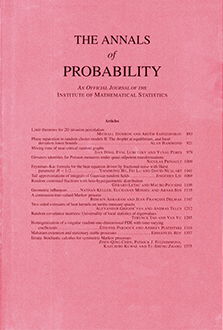Abstract
This paper is concerned with a stochastic model for the spread of an epidemic among a population of n individuals, labeled $1,2,\ldots,n$, in which a typical infected individual, i say, makes global contacts, with individuals chosen independently and uniformly from the whole population, and local contacts, with individuals chosen independently according to the contact distribution ${V_{i}^{n} = \{ v_{i,j}^{n} ; j=1,2, \ldots, n \}}$, at the points of independent Poisson processes with rates $\lambda_G^{n}$ and $\lambda_L^{n}$, respectively, throughout an infectious period that follows an arbitrary but specified distribution. The population initially comprises $m_n$ infectives and $n-m_n$ susceptibles. A sufficient condition is derived for the number of individuals who survive the epidemic to converge weakly to a Poisson distribution as $n \to \infty$. The result is specialized to the households model, in which the population is partitioned into households and local contacts are chosen uniformly within an infective's household; the overlapping groups model, in which the population is partitioned in several ways and local mixing is uniform within the elements of the partitions; and the great circle model, in which $v_{i,j}^{n} = v_{(i-j)_{\mod n}}^{n}$.
Citation
Frank Ball. Peter Neal. "Poisson approximations for epidemics with two levels of mixing." Ann. Probab. 32 (1B) 1168 - 1200, January 2004. https://doi.org/10.1214/aop/1079021475
Information





